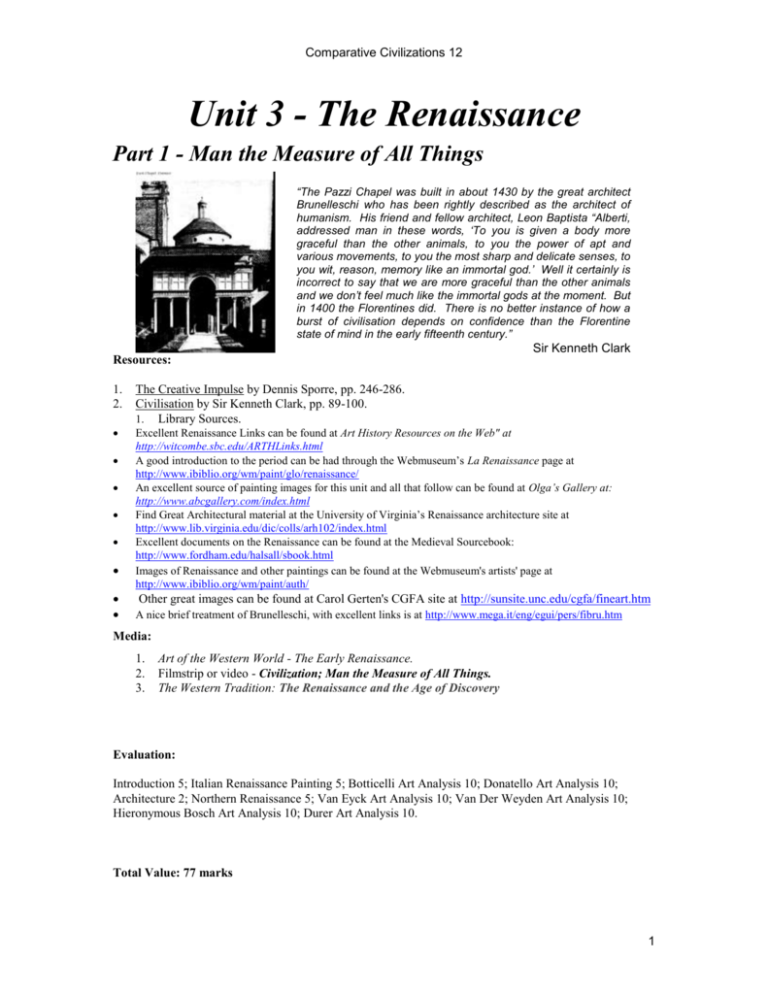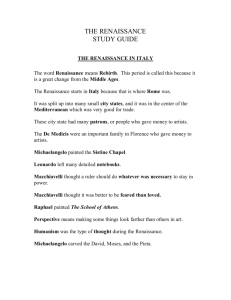ManThe Measure06
advertisement

Comparative Civilizations 12 Unit 3 - The Renaissance Part 1 - Man the Measure of All Things “The Pazzi Chapel was built in about 1430 by the great architect Brunelleschi who has been rightly described as the architect of humanism. His friend and fellow architect, Leon Baptista “Alberti, addressed man in these words, ‘To you is given a body more graceful than the other animals, to you the power of apt and various movements, to you the most sharp and delicate senses, to you wit, reason, memory like an immortal god.’ Well it certainly is incorrect to say that we are more graceful than the other animals and we don’t feel much like the immortal gods at the moment. But in 1400 the Florentines did. There is no better instance of how a burst of civilisation depends on confidence than the Florentine state of mind in the early fifteenth century.” Sir Kenneth Clark Resources: 1. 2. The Creative Impulse by Dennis Sporre, pp. 246-286. Civilisation by Sir Kenneth Clark, pp. 89-100. 1. Library Sources. Excellent Renaissance Links can be found at Art History Resources on the Web" at http://witcombe.sbc.edu/ARTHLinks.html A good introduction to the period can be had through the Webmuseum’s La Renaissance page at http://www.ibiblio.org/wm/paint/glo/renaissance/ An excellent source of painting images for this unit and all that follow can be found at Olga’s Gallery at: http://www.abcgallery.com/index.html Find Great Architectural material at the University of Virginia’s Renaissance architecture site at http://www.lib.virginia.edu/dic/colls/arh102/index.html Excellent documents on the Renaissance can be found at the Medieval Sourcebook: http://www.fordham.edu/halsall/sbook.html Images of Renaissance and other paintings can be found at the Webmuseum's artists' page at http://www.ibiblio.org/wm/paint/auth/ Other great images can be found at Carol Gerten's CGFA site at http://sunsite.unc.edu/cgfa/fineart.htm A nice brief treatment of Brunelleschi, with excellent links is at http://www.mega.it/eng/egui/pers/fibru.htm Media: 1. 2. 3. Art of the Western World - The Early Renaissance. Filmstrip or video - Civilization; Man the Measure of All Things. The Western Tradition: The Renaissance and the Age of Discovery Evaluation: Introduction 5; Italian Renaissance Painting 5; Botticelli Art Analysis 10; Donatello Art Analysis 10; Architecture 2; Northern Renaissance 5; Van Eyck Art Analysis 10; Van Der Weyden Art Analysis 10; Hieronymous Bosch Art Analysis 10; Durer Art Analysis 10. Total Value: 77 marks 1 Comparative Civilizations 12 Introduction: 1. 2. 3. 4. 5. 6. 7. What does the term Renaissance mean? When did it begin and how long did it last? What were some of the identifying characteristics of the period? Explain the meaning of the term Humanism. What new social and economic class was emerging in the Italian city states in the late 1300’s? What leading Florentine family patronized the arts and encouraged scholarship? Briefly describe the important contributions of two members of the family to the development of Renaissance art and architecture. The video insists that the Middle Ages couldn’t assimilate the past but the Florentine Renaissance could. What does this mean and why is it important to our understanding of the Renaissance? The Italian Renaissance: Painting: 1. 2. 3. 4. Identify several elements which brought about artistic breakthroughs in cities like Florence in the late 15th and early 16th centuries. What contributions did Filippo Brunelleschi make to the art of painting? Identify the meaning of the term Neo-Platonism and explain it in your own words. Who was the leading Renaissance painter of this school? How did this philosophy determine the subject matter of his paintings. Complete an art work analysis of one of Botticelli’s works. Sculpture: 1. Complete an art work analysis of Donatello’s David. Explain in your analysis why it has been suggested that this work combined “technical virtuosity” and “erotic suggestion all armoured in the word of God.” Architecture: 1. With what mammoth construction project was Filippo Brunelleschi associated? How did the architectural designs of Brunelleschi differ from those of the Gothic period? Be sure to mention specific buildings and provide images to support what you say. The Northern Renaissance (Note that this encompasses a much longer time span than that covered by this section of the Italian Renaissance and that the artists are sometimes described as Late Gothic.) 1. 2. 3. 4. 5. 6. The video describes the world’s most famous wedding portrait by Jan van Eyck. Why is this image so famous and what do you think of it? Explain why van Eyck is considered one of the great artistic masters of all time. Describe the accomplishments of Rogier Van der Weyden, Hieronymous Bosch, and Albrecht Durer. Why are they also considered great and important masters? Select one of van Eyck’s other works and complete an art work analysis on it. Complete an art work analysis on one of the works of Rogier van der Weyden. Complete an art work analysis on one of the works of Hieronymous Bosch. Complete an art work analysis on one of the works of Albrecht Durer. 2







